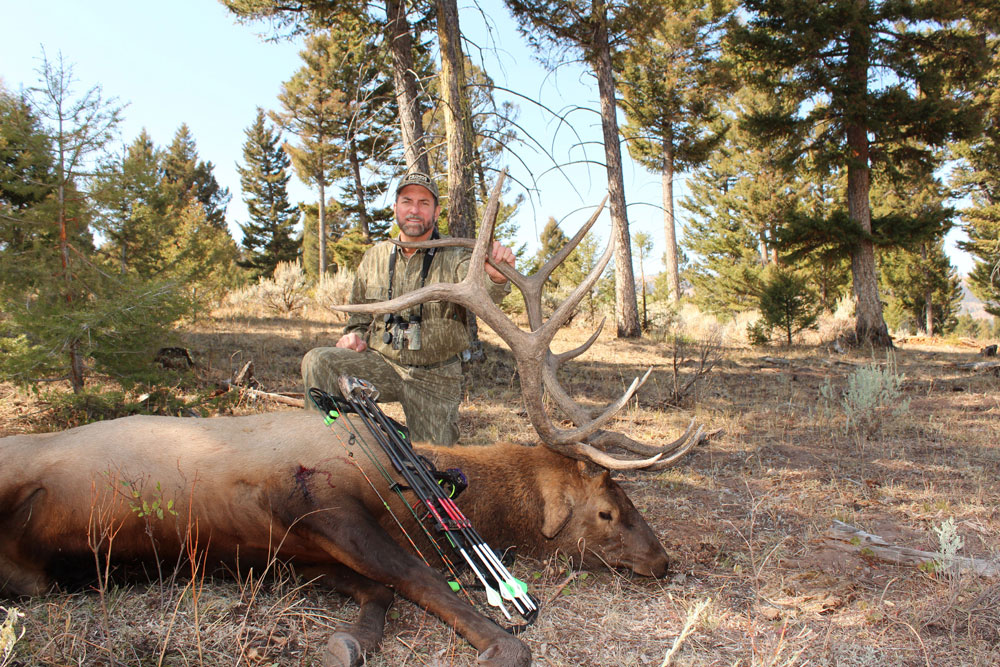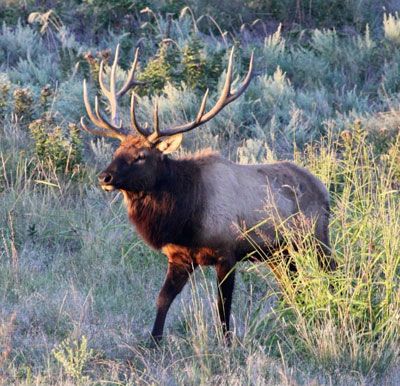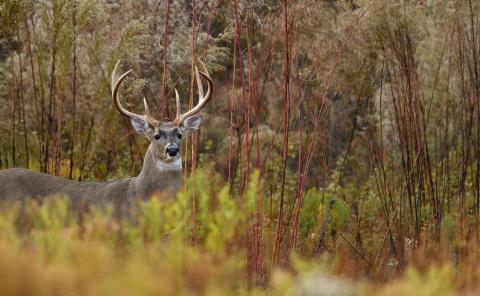provided by John Phillips
Longtime Mossy Oak Pro Will Primos of Flora, Mississippi, has been hunting elk every year since 1988. He said, “I’ve had some fantastic opportunities in my lifetime to call in hundreds of bull elk.” Primos, the creator of Primos Hunting hunts for elk in three states annually. He’s been producing videos and products for the elk-hunting industry for many years. “We wanted to get the public excited about not just elk but hunting and protecting them as well,” he said. “We’re strong supporters of the Rocky Mountain Elk Foundation and its mission.” Primos doesn’t just call and take elk himself, he also guides and calls for other people. Primos has taken or called more than 200 elk for others for his videos, “Primos The Truth 19: Big Bulls Video.”

When we hear the elk bugle or reach the spot where we want to call, the shooter, the cameraman and the caller usually will be standing together. One of the three of us will make a call and hopefully the elk will bugle. The caller then will start walking behind the shooter and the cameraman. While he’s walking, he’ll pick up a limb and hit it on the side of a pine, making a cracking sound. When he sees a rock, he’ll kick it down a hill, doing the best he can to sound like an elk stomping and running around. Elk are very noisy animals, and the caller’s racket will spook a whitetail. However, that same loud noise will call a bull elk.
One of the most important elements of being a successful caller (before the caller walks off behind the shooter and the cameraman) is to look for a landmark that he can see 75-150 yards away from the other two. Once the caller determines that he’s 75-150 yards away from the shooter, he’ll either move to the right or the left side of the shooter, depending on which way he thinks the bull will move toward the shooter. But the caller’s definitely not being quiet when he’s trying to get into the position to stop the elk by calling.
 We currently have a signal, which is three, quick, fast moos that tell the caller to come back toward us because we’ve either made the shot, or we want to regroup and move. Remember that generally the caller may not be able to see us and/or see the bull coming in, and he probably won’t be able to see or hear when we shoot. Once the caller finally reaches the distance that he wants to be from the shooter, he’ll be giving cow calls, breaking sticks and throwing rocks down the hill. If he can’t hear the elk bugle or growl, he’ll go silent and won’t call or make elk sounds. The caller may see the bull coming in-between him and the shooter. When he shuts up, the shooter and the cameraman will wonder what’s happening. The shooter or the cameraman may bugle or growl to try to get the bull to come in to the shooter. So, there are a lot of sounds that a caller needs to make that aren’t elk calls. If you’ve ever listened to a herd of elk walking through the woods, you know they make quite a bit of noise. If you can simulate that noise and add elk calls to it, then you’ve got a better chance of pulling that bull in front of the shooter.
We currently have a signal, which is three, quick, fast moos that tell the caller to come back toward us because we’ve either made the shot, or we want to regroup and move. Remember that generally the caller may not be able to see us and/or see the bull coming in, and he probably won’t be able to see or hear when we shoot. Once the caller finally reaches the distance that he wants to be from the shooter, he’ll be giving cow calls, breaking sticks and throwing rocks down the hill. If he can’t hear the elk bugle or growl, he’ll go silent and won’t call or make elk sounds. The caller may see the bull coming in-between him and the shooter. When he shuts up, the shooter and the cameraman will wonder what’s happening. The shooter or the cameraman may bugle or growl to try to get the bull to come in to the shooter. So, there are a lot of sounds that a caller needs to make that aren’t elk calls. If you’ve ever listened to a herd of elk walking through the woods, you know they make quite a bit of noise. If you can simulate that noise and add elk calls to it, then you’ve got a better chance of pulling that bull in front of the shooter.
When the shooter spots the elk coming through the woods, he must make a decision. If the shooter decides he’s shooting the bull, he never looks at the elk’s antlers or head again. Instead, the shooter looks at the spot where he wants to place the arrow. The shooter also analyzes the angle that the bull is coming toward him, because no one wants to take a head-on shot or to shoot when the bull’s sharply angling away from him. The shooter pays attention to the elk’s front legs as well. If legs are forward, exposing the kill zone, he can shoot. The shooter also notes the tree or the rock that the bull has to walk by to know the range that he is from the bull.
I never shoot an elk if I don’t know the range I am from him. My number-one rule is: if I don’t know the range, I don’t shoot. Many times, when you see a huge elk coming in, you’ll think he’s 20 yards away when he’s really 35 yards away. Knowing the range allows you to shoot accurately. When the elk’s head goes behind a tree or a rock, the shooter makes his draw. Once the elk steps out, the shooter or the cameraman makes a really soft mew (cow elk call) to stop the elk. When the elk stops, my sight pin is already behind the elk’s shoulder, and I can release the arrow.
Another thing that you shouldn’t do is take an elk when he’s walking. I took a shot at a walking elk in 1990 when he was only 18 yards away. I told myself, “This is a piece-of-cake shot.” I aimed right behind the bull’s shoulder, and my arrow hit 16 inches behind the spot where I’d aimed. I hit the elk in the gut. I spent the next day looking for my elk until I found him. So, I learned my lesson. Since that day, I always try to stop my elk before I shoot.




























